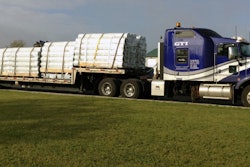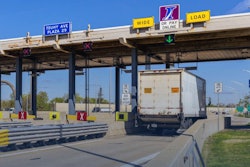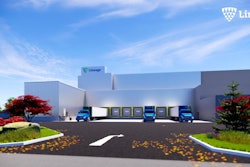Traffic congestion is more than just an inconvenience for truck drivers. It’s a major cost for the trucking industry as a whole.
A new report from the American Transportation Research Institute tracking congestion costs for 2021 found that delays in traffic cost the industry $94.6 billion -- the highest level yet recorded by the research organization.
Joining Matt and Jason this week is ATRI vice president Jeffrey Short, who talks about the findings of the latest Cost of Congestion report and what is being done to address congestion around the country.
Contents of this video
00:00 10-44 into
00:31 Traffic congestion
01:03 Cost of Congestion report
02:52 Calculating the cost of time in traffic
05:50 Total cost of congestion across the U.S.
07:46 States with the highest cost of congestion
08:56 2021 Infrastructure Investment and Jobs Act
Jason Cannon:
This week's 10-44 is brought to you by Chevron Delo 600 ADF Ultra Low Ash Diesel engine oil. It's time to kick some ash.
Matt Cole:
Traffic Congestion cost trucking more than $90 billion in 2021. How is that impacting the industry? And what can be done about it?
Jason Cannon:
You're watching CCJ's 10-44, a weekly webisode that brings you the latest trucking industry news and updates from the editors of CCJ. Don't forget to subscribe and hit the bell for notifications so you'll never miss an installment of 10-44.
Hey everybody, welcome back. I'm Jason Cannon, and my co-host on the other side is Matt Cole. Traffic congestion is more than just an inconvenience for truck drivers. It's a major cost for the trucking industry, as a whole.
Matt Cole:
A new report from the American Transportation Research Institute tracking congestion costs for 2021 found that delays in traffic costs the industry $94.6 billion, the highest level yet recorded by the organization. Joining us this week is ATRI Vice President, Jeffrey Short, who talks about the findings of the latest cost of congestion report and what is being done to address congestion around the country.
Jeffrey Short:
ATRI has been conducting research in the area of traffic congestion for more than 20 years. A lot of the work that we do in this area is from aggregated anonymous GPS data that looks at aggregated average speeds over times on roadway segments to start to identify which areas of roadway are the worst. So, when we first started doing this many, many years ago, I've been with ATRI, actually, 20 years now coming up in December, and one of my first activities with ATRI, one of my first research activities, was saying can we do this for, let's say, 50-mile stretches of roadway? Can we say this road is good, this road is bad, there's delay here? And, really, it's gotten to the point where we can look down at very small pieces of road segments, like we do with our bottleneck report, and we zoom in on those choke points and say this is the part of the choke point that's bad.
We put out a bottleneck list every single year with the top bottlenecks in the country that are impacting freight. And what we've done here with this new report, the Cost of Congestion, is look at what all those costs add up to, on all the roadway segments, what those costs add up to for the trucking industry. Like you said, this isn't the first time we've collected the cost of congestion data and put that information together. We've been doing it since 2014, and that was when our first report came out. We had one in '15 and '16, and we looked at the situation and said we really need to do an update. So, what this report provides is five years of cost of congestion data, with the most recent year being 2021.
Jason Cannon:
ATRI uses a number of different factors including speed, volume, and more to calculate the cost of the time a truck spends sitting in traffic.
Jeffrey Short:
First and foremost, like I mentioned, we have the truck speeds. That's very important to identify areas where trucks aren't moving as fast as they should. Let's take Atlanta, Georgia, where I live. I always use that as an example because I live through this traffic every single day. And what we have at a location called Spaghetti Junction is trucks going about 15 miles per hour during the rush hour on a 16 lane highway. And that's not the way it should be, and trucks are able to move at free flow speed at night. So, it's really just too many vehicles. So, we identify those spots where there are too many vehicles. Then, we look at volume. Now, volume changes every year.
Volume is estimated at the federal level, and we have our own ways of looking at volume, as well. And when volume increases in a certain area or during a certain year, that means more trucks are exposed to this congestion, so we know how many trucks are being impacted by it. And then, the final component is our operational cost of trucking. How much does it cost per hour to operate a truck? And that cost is applied to every single hour of delay that we have. And going into those costs, of course, are driver wages, fuel costs, equipment costs because equipment that isn't earning is obviously sitting there losing money, for the most part. So, that is what goes into these costs.
Matt Cole:
The total cost of congestion across the US rose $20 billion from 2016 to 2021, even with declines in 2019 and 2020. We'll hear more about why after word from 10-44 sponsor, Chevron Lubricants.
Jason Cannon:
Protecting your diesel engine and its after treatment system has traditionally been a double-edged sword. The same engine oil that is so essential to protecting your engine's internal parts is also responsible for 90% of the ash that is clogging up your DPF and upping your fuel and maintenance costs. Outdated industry thinking still sees a trade-off between engine and emission system protection, and Chevron was tired of it. So, they spent a decade of R&D developing a no compromise formulation. Chevron Lubricants developed a new ultra low ash diesel engine oil that is specifically designed to combat DPF ash clogging.
Delo 600 ADF with OmniMax technology cuts sulfate ash by whopping 60%, which reduces the rate of DPF clogging and extends DPF service life by two and a half times. And just think what you can do with all the MPGs you're going to add from cutting your number of regens. But Delo 600 ADF isn't just about after treatment. It provides complete protection, extending drain intervals by preventing oil breakdown. Before you had to choose between protecting your engine or your after treatment system, and now you don't. 600 ADF from Delo with OmniMax technology, it's time to kick some ash.
Jeffrey Short:
In 2016, looking back to our last report, the total annual cost of congestion to the trucking industry across the United States was $74.5 billion, and that continued to increase to $80 billion, $87 billion by 2018. In 2019, there was a dip down to about $79 billion, and then 2020 went back down even further to $77 billion. All right, so we're down at $77 billion. There's a lot of freight volume, like I said. The economy, as far as purchasing goods, is going pretty well. Lots of trucks on the road. Then, 2021 hits, and things start to slow down. We saw it in our bottleneck report with congestion, and what that means is our total annual cost of congestion in the most recent year, 2021, was $94.6 billion. So, we're nearing a hundred billion dollars here.
We may hit that soon when we analyze the 2022 data, because of the increase in costs of fuel, increasing costs of equipment. Obviously, drivers are being paid more in 2021, so the congestion has also likely got worse. So, that is our big finding is the $94.6 billion cost. I am predicting that this will go up. So, what does that mean? How many hours did the trucking industry lose? We lost 1.27 billion hours due to delay. So, that is 1.27 billion hours of drivers just sitting there. It's the equivalent of more than 460,000 truck drivers just sitting idle for a single year. So, that is a lot of downtime, a lot of inefficiency, and certainly something worth addressing as far as infrastructure funding fixing these choke points.
Jason Cannon:
The states with the highest cost of congestion really shouldn't come as a surprise to anybody in trucking, although the order of the states did shuffle some from the last report in 2016.
Jeffrey Short:
At the state level, I found the most interesting changes to be that California actually rose to the top. I was a little surprised by that, but their total congestion costs were $9 billion. And then, we have Texas with $7 billion, and Florida with another $7 billion. And, finally, New York State, which includes New York City, at $4.9 billion. So, those are the largest states population wise. It's normal that they would be in the top four. They have a good portion of the population, a good portion of the economic activity in the United States. But then, we go to number five, and we have Louisiana and, number six, Georgia. Georgia, in particular, is a state that continues to grow, and Louisiana has been called out in several forums for having infrastructure that's not up to the average infrastructure, I guess I'll say, which causes slowdowns. So, infrastructure investment is clearly needed in that area.
Matt Cole:
Jeffrey says the 2021 Infrastructure Investment and Jobs Act provides for $350 billion for highway investments, which could be used to alleviate congestion, ATRI hopes its report serves as a wake-up call to show the problems trucking faces.
Jeffrey Short:
A lot of folks have heard of the Bipartisan Infrastructure Investment and Jobs Act. It has a couple different names. Some folks call it the IIJA. It went through Congress. It was a bill that was signed by the President in 2021, and what that includes is $350 billion for highway investments, and these highway investments could be used to alleviate congestion and could be used specifically to alleviate freight congestion. What we've provided with this report is a wake-up call saying, "Let's bring some of that money over here because we could certainly fix infrastructure in certain places and decrease these congestion costs over time." So, in the report, we included a long list of how much could be allocated at the state level, what each state's congestion costs are, and then how many projects are currently underway that may help towards the goal of alleviating congestion for truck drivers.
As an industry, we are already putting in fuel tax dollars towards the highway trust fund that is, then, allocated to roadways. This is our workplace. So, we have a vested interest in making sure the roadways function well and have been more than willing to pay billions and billions every single year towards the highway trust fund, towards state highway funds, as well. Certainly continuing to pay your taxes, you don't really have a choice there, but that is one way to help alleviate congestion. But, all joking aside, the trucking industry, we are, for the most part, a for-hire industry. So, folks hire us to deliver, to move something from here to here, at a certain time, and it needs to be there on time and to a certain place.
We don't really have a choice. I'm sure if folks had a choice, they could avoid bottlenecks, but the problem is you have to keep the freight moving to keep it on time. So, certainly with hours of service flexibility and that sort of thing, there are techniques that can be employed to avoid congestion as long as you can stay on schedule and that sort of thing. From the back office perspective, if there is any way to avoid congestion, if there's any way to get that message out to drivers that they should take this route instead of this route, that certainly is beneficial.
Jason Cannon:
That's it for this week's 10-44. You can read more on CCJdigital.com. While you're there, sign up for our newsletter, and stay up to date on the latest in trucking industry news and trends. If you have any questions or feedback, please let us know in the comments below. Don't forget to subscribe and hit the bell for notifications so you can catch us again next week.










